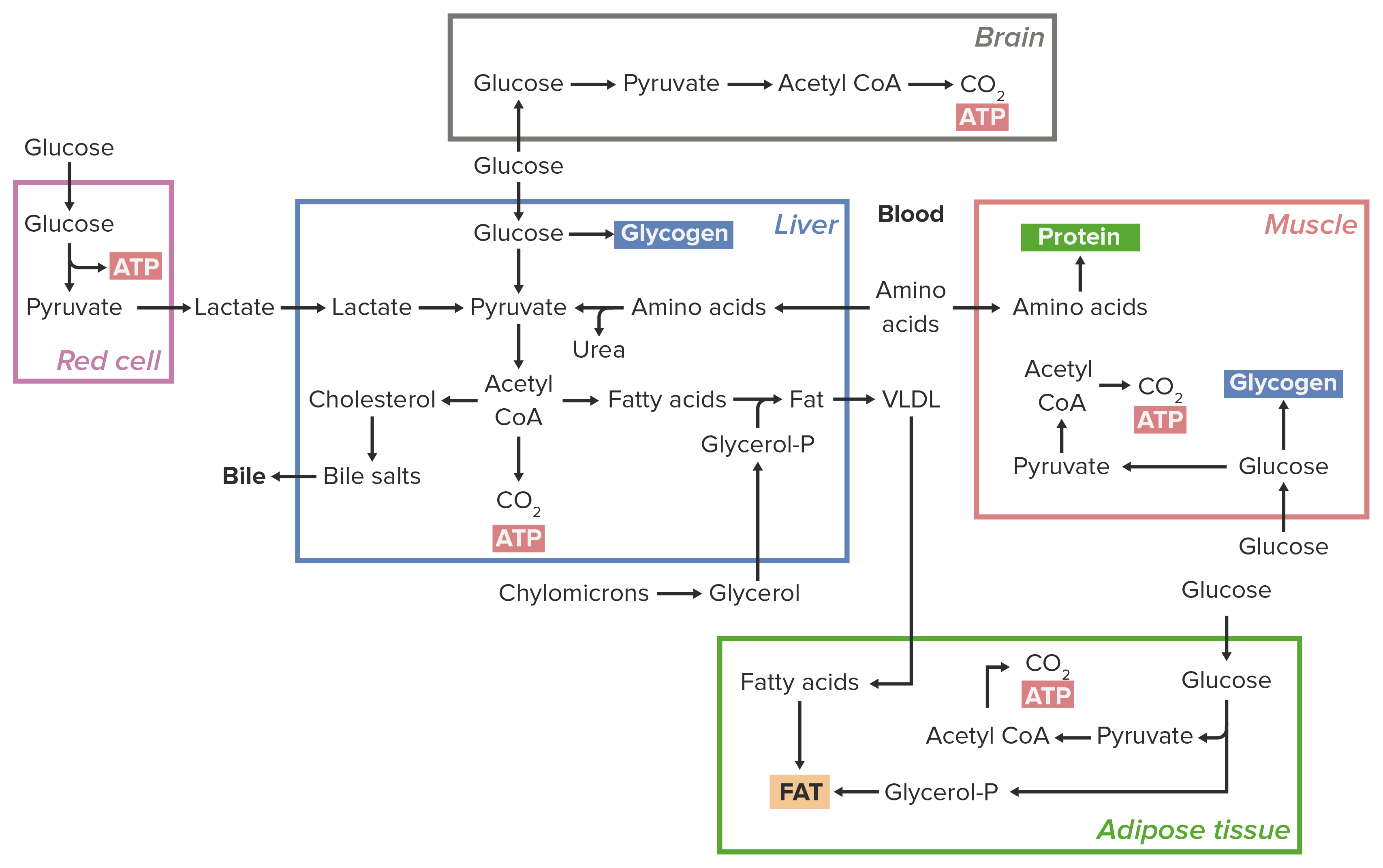Playlist
Show Playlist
Hide Playlist
Use of Calories
-
Slides EnergyConsiderations Nutrition.pdf
-
Download Lecture Overview
00:01 So how do we use all of these different calories, especially the ones for basal metabolic rate. 00:07 You need to know where the majority of calories go to. 00:10 So a quick graphic here to help us with that. 00:14 First of all our brain, again we have numbers on here. 00:19 You really need to consider the relativity. 00:21 So which organ uses the most calories? Right, in our basal metabolic rate, we consider the liver, which maybe surprising. 00:32 But the liver uses almost the majority of our calories, but it does an awful lot of stuff. 00:37 It's always active, it's always working for us. 00:40 As well as our brain, so that also has a fairly high caloric usage. 00:46 And then the heart and kidneys are pretty active in using calories. 00:52 And then skeletal muscle, well of course we're using the skeletal muscle to stand up and move around at all times. 00:58 And so it is going to use surprisingly just about as much as the brain. 01:04 So the brain really does have a high demand on our caloric intake. 01:10 All the other organs fit in the other slices of the pie. 01:12 So don't go memorizing the numbers, understand the major users of our basal metabolic rate, the calories attributed to that. 01:24 Brain, liver, skeletal muscle, heart and kidney, Relative proportions are good enough. 01:29 Because again, sources will vary on the specific percentages. 01:34 So any calories that we consumed above and beyond, are basal metabolic needs pictured here, are going to be stored, right. 01:43 And we generally store them as fat. 01:46 And they can become an issue if we have an imbalance in the intake and output of those calories. 01:56 We need to consider for your exam, what calories come from? You are familiar with the major macromolecules, carbohydrates, proteins, fats. 02:07 Those are our sustenance and then of course alcohol is an additional consideration for us when we're considering nutrition. 02:16 You can see the USDA's recommendations of portion sizes. 02:22 We moved from the pyramid to this full plate concept, with all the different proportions in various places. 02:32 There are different arguments as to what are the ideal proportions of proteins, carbohydrates and fats. 02:38 But for the purposes of your exam, the standard here is probably going to be what they hit on most heavily. 02:45 So keep these numbers in mind, 4 calories and 4 calories. 02:50 Sometimes you'll see carbohydrates noted as 4.5. 02:54 Seems from more sources 4 is good enough. 02:58 Alcohol 7 calories per gram, and fat having the most calories per gram because it is an excellent calorie storage spot. 03:07 So, what you will also want to do is recall where each of the different fuels are utilized in cellular respiration or metabolism. 03:19 And I'm certain that you've spent plenty of time examining those between anatomy and physiology, between cell and molecular biology and in biochemistry, for certain. 03:33 You probably know many of the intermediates along the pathway. 03:37 And what you need to remember in this census of nutrition is where each of these sources enter into the respiratory cycle. 03:47 So is it utilized in glycolysis? Is it utilized in the Krebs cycle? And where are the intermediaries coming into there. 03:56 And again that has been covered in the cellular respiration lectures. 04:00 So keep those pathways in mind. 04:06 The one that we may have not spent as much time in is alcohol metabolism. 04:12 Alcohol metabolism is a particularly hot topic in the multi-disciplinary area of nutrition for the exams. 04:21 I think you've seen the pathway before. 04:23 I want to alert you to two key enzymes, alcohol dehydrogenase, which is involved in conversion of ethanol and some other alcohols to acetaldehyde. 04:34 And then acetaldehyde dehydrogenase taking more hydrogens off. 04:39 And the formation of acetate which can easily enter into the Krebs or TCA cycle, so that it can be metabolized. 04:48 Acetate is harmless. 04:50 Acetaldehyde on the other hand is another story. 04:54 It turns out to be fairly toxic. 04:57 A couple of drugs to consider, there is Formepizole. 05:05 And that is involved in treatment of alcohol poisoning. 05:10 So ethylene glycol or methanol poisoning. 05:13 It's administered to deactivate alcohol dehydrogenase. 05:18 And prevent toxicity from the build up of formaldehyde and formic acid. 05:23 In the case of methanol and a buildup of glycol aldehyde glycol eight gly oxalate and oxalate in the case of ethylene glycol. 05:35 The next drug that you should be familiar with is disulfiram or antabuse. 05:41 Now you probably heard that the symptoms of taking this drug and drinking alcohol are quite formidable in sense of a really, really bad hangover. 05:54 And that is because acetaldehyde dehydrogenase is inactivated and that results in a build up of acetaldehyde. 06:04 And excessive acetaldehyde is what causes the classic symptoms of a hangover. 06:11 So usually the hangover results from having sort of a back log in the activity of these enzymes. 06:18 So we have a build up of intermediaries creating a hangover. 06:22 Antabuse locks that creating greater symptoms and ideally prohibiting the individual from wanting to consume alcohol cause it feels so awful. 06:34 Anyway that's what you need to know on the basics of alcohol metabolism as far as nutrition is concerned.
About the Lecture
The lecture Use of Calories by Georgina Cornwall, PhD is from the course Nutrition. It contains the following chapters:
- Use of Calories
- Alcohol Metabolism
Included Quiz Questions
At rest, which organ consumes as many calories as all the skeletal muscles?
- Brain
- Spleen
- Kidneys
- Heart
- Lungs
Which of the following effects makes disulfiram a good choice for the treatment of alcohol dependence?
- It discourages drinking by inhibiting the breakdown of acetaldehyde.
- It eliminates the craving for alcohol in a person with an alcohol use disorder.
- It decreases the toxicity of alcohol.
- It mimics the mechanism of action of fomepizole without the same side effects.
- It converts alcohol into acetate.
How many calories are present in 1 gram of fat?
- 9
- 4
- 5
- 7
- 4.5
Customer reviews
5,0 of 5 stars
| 5 Stars |
|
1 |
| 4 Stars |
|
0 |
| 3 Stars |
|
0 |
| 2 Stars |
|
0 |
| 1 Star |
|
0 |
Concise and relevant for the USMLE Step 1! Easy to understand !




